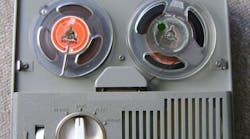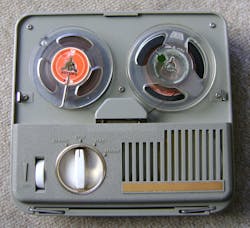One of my favorite toys as a pre-teen was a tape recorder, which brought many, many hours of creative entertainment. After recording various bodily function noises (some genuine, others fabricated) toilet flushings, etc., my friends and I graduated to making parodies of TV and radio commercials, TV shows, and even made our own skits. But my first tape recorder also taught me my first lesson in drive design, although I’m getting ahead of myself.
My first tape recorder was a real cheapie, and quite primitive. We’re talking about the old reel-to-reel jobs — early sixties, just before cassettes fell into favor. This machine drove a takeup reel at a constant rotational speed to pull the tape past a record and playback head. The trouble is, as more and more tape wound around the takeup reel, its effective diameter increased, so the tape at the beginning of the reel traveled at a slower linear speed than tape did at the end.
This simple setup posed no problem as long as I recorded and played back tapes on the same machine. However, I noticed a big difference when I got my second reel-to-reel machine. The new one worked great, but when I played back tapes that had been recorded on the old machine, the speed was off. The beginning of tapes played too fast, and the end of tapes played too slow. Further study revealed the problem.
The new reel-to-reel machine used what I later learned is called a capstan drive. Capstans were used by most reel-to-reel tape recorders, and many years later I learned that they are used extensively in industry. They serve as an effective way to maintain constant linear speed of material winding onto or unwinding from a spool or reel.
Unlike my first tape recorder, the second one’s motor didn’t drive the tape takeup spindle directly. Instead, it drove the spindle through a torque-limiting clutch. The clutch transmitted just enough torque to spin the takeup reel and apply tension to the tape. The tape itself got pinched between a pair of rollers (the capstan) spinning at a constant speed. This allowed the tape to run at a constant speed, regardless of how much tape was on the takeup reel.
So even though this wasn’t my first lesson in fluid power, it did provide an important lesson in drive design and motion control. I just didn’t call it that.

Continue Reading
Continue Reading
Motor leakage variations
Oct. 18, 2006
Sponsored Recommendations
Sponsored Recommendations
How Variable Volume Pumps Work
Feb. 6, 2024
What is a Check Valve and How Does it Work?
Feb. 6, 2024


